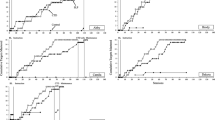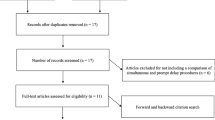Abstract
An adapted alternating treatment design was used to measure the effectiveness of constant time delay and simultaneous prompting procedures within an embedded instruction format on the acquisition of academic skills. Four middle school students with moderate to severe disabilities and the paraprofessionals who supported these students in their general education classes participated in the study. The results of the study indicated that both procedures were effective in promoting the acquisition of the target skills. However, the constant time delay procedure was more effective for two of the students and the simultaneous prompting procedure was more effective for the remaining students. Results are discussed in terms of future research and implications for supporting the inclusion of students with moderate and severe disabilities in general education classes.
Similar content being viewed by others
References
Ault, M. J., Gast, D. L., & Wolery, M (1988). Comparison of progressive and constant time-delay procedures in teaching community-sign word readings. American Journal on Mental Retardation, 93(1), 44-56.
Caldwell, N. K., Wolery, M., Werts, M. G., & Cladwell, Y. (1996). Embbedding instructive feedback into teacher-student interactions during independent seat work. Journal of Behavioral Education, 6(4), 559-480.
D'Alonzo, B. J., Giordano, G., & Vanleeuwen, D. M. (1997). Perceptions by teachers about the benefits and liabilities of inclusion. Preventing School Failure, 42, 4-11.
Doyle, P. M., Gast, D. L., Wolery, M., Ault, M. J., & Farmer, J. A. (1990). Use of constant time delay in small group instruction: A study of observational learning. The Journal of Special Education, 23(4), 369-385.
Dunlap, L. K., & Dunlap, G. (1987). Using task variation to motivate handicapped students. Teaching Exceptional Children, 19(4), 16-19.
Fickel, K. M., Schuster, J. W., & Collins, B. C. (1998). Teaching different tasks using different stimuli in a heterogeneous small group. Journal of Behavioral Education, 8(2), 219-244.
Fox, L., & Hanline, M. F. (1993). A preliminary evaluation of learning within developmentally appropriate early childhood settings. Topics in Early Childhood Special Education, 13, 308-327.
Gaylord-Ross, R. J., & Holvoet, J. F. (1985). Strategies for education students with severe handicaps. Boston: Little, Brown, and Company.
Guess, D., & Helmstetter, E. (1986). Skill cluster instruction and the individualized curriculum sequencing model. In R. H. Horner, L. H. Meyer, & H. D. Bud Fredericks (Eds.), Education of learners with severe handicaps: Exemplary service strategies (pp. 221-250). Baltimore: Paul H. Brookes.
Holcombe, A., Wolery, M., & Gast, D. L. (1994). Comparative single-subject research: Descriptions of designs and discussion of problems. Topics in Early Childhood Education, 14(1), 119-145.
Horner, R. H., Dunlap, G., & Koegel, R. L. (1988). Generalization and maintenance: Life-style changes in applied settings. Baltimore: Paul H. Brookes.
Harrower, J. (1999). Educational inclusion of children with severe disabilities. Journal of Positive Behavioral Interventions, 1, 215-230.
Hunt, P. & Goetz, L. (1997). Research on inclusive educational programs, practices, and outcomes for student with severe disabilities. The Journal of Special Education, 31, 3-29.
Johnson, P., Schuster, J., & Bell, J. K. (1996). Comparison of simultaneous prompting with and without error correction in teaching science vocabulary words to high schools students with mild disabilities. Journal of Behavioral Intervention, 6(4), 437-458.
Kaiser, A. P., Ostrosky, M. M., & Alpert, C. L. (1993). Training teachers to use environmental arrangement and milieu teaching with nonvocal preschool children. Journal of the Association for Persons with Severe Handicaps, 18, 188-199.
Kaiser, A. P., Yoder, P. J., & Keetz, A. (1992). Evaluating milieu teaching. In S. F. Warren & J. Reichle (Eds.), Causes and effects in communication and language intervention (pp. 9-47). Baltimore: Paul H. Brookes.
Lipskey, D. K., & Gartner, A. (1997). Inclusion and School Reform: Transforming America's Classrooms. Baltimore: Paul H. Brookes.
Losardo, A., & Bricker, D. (1994). Activity-based intervention and direct instruction: A comparison study. American Journal on Mental Retardation, 98, 744-765.
McDonnell, J. (1998). Instruction for students with severe disabilities in general education settings. Education and Training in Mental Retardation and Developmental Disabilities, 33, 199-215.
McDonnell, J., Johnson, J. W., Polychronis, S., & Riesen, T. (2002). The effects of embedded instruction on students with moderate disabilities enrolled in general education classes. Education and Training in Mental Retardation and Developmental Disabilities, 37, 363-377.
Sailor, W., & Guess, D. (1983). Severely handicapped students: An instructional design. Boston: Houghton Mifflin Company.
Singleton, K. C., Schuster, J. W., Ault, M. J. (1995). Simultaneous prompting in a small group instructional arrangement. Education and Training in Mental Retardation and Developmental Disabilities, 218-230.
Snell, M., & Brown, F. (2000). Instruction of students with severe disabilities (6th edition). New York: Merrill.
Snell, M. F., & Gast, D. L. (1981). Applying time delay procedures to the instruction of the severely handicapped. Journal of the Association for Persons with Severe Handicaps, 6(3), 3-14.
Schuster, J. W., Griffen, A. K., & Wolery, M. (1992). Comparison of simultaneous prompting and constant time delay procedures in teaching sight words to elementary students with moderate mental retardation. Journal of Behavioral Education, 2(3), 305-325.
Tekin, E. Kircaali-Iftar, G. (2002). Comparison of the effectiveness and efficiency of two response prompting procedures delivered by sibling tutors. Education and Training in Mental Retardation and Developmental Disabilities, 37(3), 283-299.
Venn, M. L., Wolery, M., Werts, M. G., Morris, A., Decesare, L. D., & Cuffs, J. S. (1993). Embedding instruction in art activities to teach preschoolers with disabilities to imitate their peers. Early Childhood Research Quarterly, 8, 277-294.
Warren, S. F. (1992). Facilitating basic vocabulary acquisition with milieu teaching procedures. Journal of Early Intervention, 16, 235-251.
Westling, D. L., & Fox, L. (2000). Teaching students with severe disabilities (2nd edition). Upper Saddle River, NJ: Merrill.
Wolery, M. (1996). Early childhood special and general education. In R. A. McWilliam (Ed.), Rethinking pull-out services in early intervention: A professional resource (pp. 185-216). Baltimore: Paul H. Brookes.
Wolery, M., Anthony, L., Cladwell, N. K., Snyder, E.D., & Morgante, J. D. (2002). Embedding and distributing constant time delay in circle time and transitions. Topics in Early Childhood Special Education, 22(1), 14-25.
Wolery, M., Anthony, L., & Heckathorn, J. (1998). Transition-based teaching: Effects on transitions, teacher's behavior, and children's learning. Journal of Early Intervention, 21, 117-131.
Wolery, M., Ault, M. J., & Doyle, P. M. (1992). Teaching Students with Moderate to Severe Disabilities: Use of Response Prompting Strategies. New York: Longman.
Wolery, M., Anthony, L., Snyder, E. D., Werts, M., & Katzenmeyer, J. (1997). Training elementary teachers to embed instruction during classroom activities. Education and Treatment of Children, 20(1), 40-58.
Wolery, M., Holcombe, A., Cybriwsky, C. A., Doyle, P. M., Schuster, J. W., Ault, M. J., & Gast, D. L. (1992). Constant time delay with discrete responses: A review of effectiveness and demographic, procedural, and methodological parameters. Research in Developmental Disabilities, 13, 239-266.
Author information
Authors and Affiliations
Corresponding author
Rights and permissions
About this article
Cite this article
Riesen, T., McDonnell, J., Johnson, J.W. et al. A Comparison of Constant Time Delay and Simultaneous Prompting Within Embedded Instruction in General Education Classes with Students with Moderate to Severe Disabilities. Journal of Behavioral Education 12, 241–259 (2003). https://doi.org/10.1023/A:1026076406656
Issue Date:
DOI: https://doi.org/10.1023/A:1026076406656




